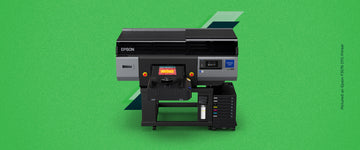The apparel printing industry is experiencing transformation due to advancements in technology. Various types of printers, inks, and transfer methods play a crucial role in determining the quality of the final product and the range of possibilities for manufacturers. Understanding the distinctions between the three main types of apparel printing – DTG (direct-to-garment), DTF (direct-to-film), and sublimation – can assist you in selecting the most suitable option for your business.
1. DTG printing (direct to garment printing)
DTG printing, as the name implies, involves printing the image directly onto the garment (or fabric, so to say) without the need for film or transfer paper. However, the garment must undergo pretreatment to ensure proper image transfer. DTG printing employs a specific type of ink and is typically ideal for printing on cotton fabric.
Here we've got a Q-and-A about DTG printing inks.
Kodak DTG inks
We've got pretreatment solutions and Kodak DTG ink in store.
2. DTF printing (direct to film printing)
DTF printing, direct to film printing, also known as film to garment printing, entails printing the image onto a film and subsequently transferring it from the film to the fabric. This method does not require pretreatment of the fabric, but a powder must be applied after transferring the image to prevent ink smudging or streaking.
Kodak DTF ink, consumables and supplies
We've got Kodak DTF ink, consumables and supplies in store.
Differences between DTG and DTF printing
More information about differences between DTG and DTF in this article: "Differences between DTG (Direct-to-Garment) and DTF (Direct-to-Film) printing technology". And what about screen printing versus direct-to-film printing?
3. Sublimation printing
Sublimation printing utilises a distinct process that sets it apart from DTG and DTF methods. Instead of printing liquid ink onto fabric or film, sublimation involves a solid ink substance transitioning directly from a solid state to a gas without becoming a liquid. The image is printed onto transfer paper and then transferred to the fabric. The ink is heated until it seamlessly blends with the fabric fibers.
Questions about sublimation printer supplies? Please don't hesitate to get in touch and reach out to our specialists if needed.
Considerations for choosing a printing type
When selecting the appropriate apparel printing method, several factors come into play.
- Firstly, consider the fabric color as it influences the effectiveness of the printing technique. Sublimation printing excels on lighter-colored fabrics, where the ink effortlessly blends into the fibers. Conversely, for black or dark colors, DTG printing proves to be a better choice.
- Additionally, the fabric type should be taken into account. DTF printing is compatible with any fabric type, while DTG yields the best results on cotton, and sublimation works wonders with polyester.
- The range of colors in your image also matters, especially when it comes to white. If your design includes white elements, opting for DTG or DTF printing may be preferable.
- Another crucial consideration is the order size versus speed... DTG is faster but pretreatment takes time. DTF and sublimation doesn't require pretreatment...
- Lastly, the texture of the final product plays a role in the decision-making process. DTG-printed items tend to have a rougher texture as the ink bonds with the fabric. In contrast, DTF printing produces a smoother texture, while sublimation printing seamlessly integrates the image with the fabric, resulting in an indistinguishable texture when touched.
By considering these factors, you can make an informed decision about the most suitable apparel printing method for your specific needs.







